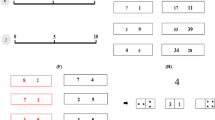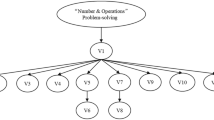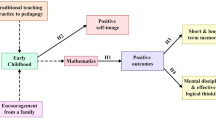Abstract
Although previous research has demonstrated that the acquisition of mathematical skills requires support from multiple cognitive abilities, the associations between cognitive precursors in different domains and mathematics at different hierarchical levels among primary school children are not well understood. This study explores the cognitive mechanisms underlying primary school children’s mathematics learning by extending the original pathways model. A total of 409 children participated v.in the study. A battery of cognitive, symbolic number processing, and mathematics measures were performed on the participants. The cognitive pathways supported children’s symbolic number skills, which in turn provided the foundation for formal mathematics. Different hierarchical mathematics skills were supported by different cognitive constellations. A hierarchical progressive development structure was found, from cognitive precursors, through symbolic number processing, to basic math fluency and complex numerical computation, and then, to problem-solving. The study also tried to divide children into two groups, grades 1–3 and 4–5. The exploratory results showed that there were commonalities and differences in the cognitive basis of mathematics learning in the two groups. These findings further explained the cognitive mechanisms underlying mathematical development in primary school children, with possible implications for the effective teaching and practice of mathematics knowledge and early identification and intervention of learning difficulties.





Similar content being viewed by others
Data availability
The dataset generated and the material analyzed during the current study will be available from the corresponding author upon reasonable request.
References
Ackerman, P. L. (1988). Determinants of individual differences during skill acquisition: Cognitive abilities and information processing. Journal of Experimental Psychology: General, 117, 288–318. https://doi.org/10.1037/0096-3445.117.3.288
Allen, K., Higgins, S., & Adams, J. (2019). The relationship between visuospatial working memory and mathematical performance in school-aged children: A systematic review. Educational Psychology Review, 31(3), 509–531. https://doi.org/10.1007/s10648-019-09470-8
Alloway, T. P., & Passolunghi, M. C. (2011). The relationship between working memory, IQ, and mathematical skills in children. Learning and Individual Differences, 21(1), 133–137.
Ashkenazi, S., Rosenberg-Lee, M., Metcalfe, A. W. S., Swigart, A. G., & Menon, V. (2013). Visuo–spatial working memory is an important source of domain-general vulnerability in the development of arithmetic cognition. Neuropsychologia, 51(11), 2305–2317. https://doi.org/10.1016/j.neuropsychologia.2013.06.031
Baron, R. M., & Kenny, D. A. (1986). The moderator–mediator variable distinction in social psychological research: Conceptual, strategic and statistical considerations. Journal of Personality and Social Psychology, 51, 1173–1182.
Barsalou, L. W. (2008). Grounded cognition. Annual Review of Psychology, 59(1), 617–645. https://doi.org/10.1146/annurev.psych.59.103006.093639
Braeuning, D., Hornung, C., Hoffmann, D., Lambert, K., Ugen, S., Fischbach, A., Schiltz, C., Hübner N., Nagengast, B., & Moeller, K. (2021). Long-term relevance and interrelation of symbolic and non-symbolic abilities in mathematical-numerical development: Evidence from large-scale assessment data. Cognitive Development, 58, 101008. https://doi.org/10.1016/j.cogdev.2021.101008.
Cai, D., Zhang, L., Li, Y., Wei, W., & Georgiou, G. K. (2018). The role of approximate number system in different mathematics skills across grades. Frontiers in Psychology, 9, 1733. https://doi.org/10.3389/fpsyg.2018.01733
Carr, M., & Alexeev, N. (2011). Fluency, accuracy, and gender predict developmental trajectories of arithmetic strategies. Journal of Educational Psychology, 103(3), 617–631. https://doi.org/10.1037/a0023864
Cheng, D., Xiao, Q., Chen, Q., Cui, J., & Zhou, X. (2018). Dyslexia and dyscalculia are characterized by common visual perception deficits. Developmental Neuropsychology, 43(6), 497–507. https://doi.org/10.1080/87565641.2018.1481068
Cirino, P. T. (2011). The interrelationships of mathematical precursors in kindergarten. Journal of Experimental Child Psychology, 108(4), 713–733. https://doi.org/10.1016/j.jecp.2010.11.004
Cirino, P. T., Tolar, T. D., Fuchs, L. S., & Huston-Warren, E. (2016). Cognitive and numerosity predictors of mathematical skills in middle school. Journal of Experimental Child Psychology, 145, 95–119. https://doi.org/10.1016/j.jecp.2015.12.010
Cornoldi, C., Rigoni, F., Venneri, A., & Vecchi, T. (2000). Passive and active processes in visuo-spatial memory: Double dissociation in developmental learning disabilities. Brain and Cognition, 43(1–3), 117–120.
Cowan, R., Donlan, C., Shepherd, D.-L., Cole-Fletcher, R., Saxton, M., & Hurry, J. (2011). Basic calculation proficiency and mathematics achievement in elementary school children. Journal of Educational Psychology, 103(4), 786–803. https://doi.org/10.1037/a0024556
Das, J. P., & Misra, S. B. (2015). Cognitive planning and executive functions. New Delhi: Sage.
Dehaene, S., Piazza, M., Pinel, P., & Cohen, L. (2003). Three parietal circuits for number processing. Cognitive Neuropsychology, 20(3), 487–506. https://doi.org/10.1080/02643290244000239
Dehaene, S. (2011). The number sense: How the mind creates mathematics, Rev. and updated ed. New York, NY: Oxford University Press.
Deng, M., Cai, D., Zhou, X., & Leung, A. W. S. (2022). Executive function and planning features of students with different types of learning difficulties in Chinese junior middle school. Learning Disability Quarterly, 45(2), 134–143. https://doi.org/10.1177/0731948720929006
Fazio, L. K., Bailey, D. H., Thompson, C. A., & Siegler, R. S. (2014). Relations of different types of numerical magnitude representations to each other and to mathematics achievement. Journal of Experimental Child Psychology, 123, 53–72. https://doi.org/10.1016/j.jecp.2014.01.013
Feigenson, L., Dehaene, S., & Spelke, E. (2004). Core systems of number. Trends in Cognitive Sciences, 8(7), 307–314. https://doi.org/10.1016/j.tics.2004.05.002
Fias, W., & Bonato, M. (2018). Chapter 12 – Which space for numbers? In A. Henik & W. Fias (Eds.). Heterogeneity of function in numerical cognition (pp. 233–242). Academic Press. Retrieved from http://www.sciencedirect.com/science/article/pii/B9780128115299000121
Finke, S., Freudenthaler, H. H., & Landerl, K. (2020). Symbolic processing mediates the relation between nonsymbolic processing and later arithmetic performance. Frontiers in Psychology, 11, 549. https://doi.org/10.3389/fpsyg.2020.00549
Friedman, N. P., Corley, R. P., Hewitt, J. K., & Wright, K. P., Jr. (2009). Individual differences in childhood sleep problems predict later cognitive executive control. Sleep, 32(3), 323–333. https://doi.org/10.1093/sleep/32.3.323
Fuchs, L. S., Gilbert, J. K., Powell, S. R., Cirino, P. T., Fuchs, D., Hamlett, C. L., & Tolar, T. D. (2016). The role of cognitive processes, foundational math skill, and calculation accuracy and fluency in word-problem solving versus prealgebraic knowledge. Developmental Psychology, 52(12), 2085–2098. https://doi.org/10.1037/dev0000227
Fuchs, L. S., Geary, D. C., Compton, D. L., Fuchs, D., Hamlett, C. L., Seethaler, P. M., Bryant, J. D., & Schatschneider, C. (2010). Do different types of school mathematics development depend on different constellations of numerical versus general cognitive abilities?. Developmental Psychology, 46(6), 1731. https://doi.org/10.1037/a0020662
Georgiou, G. K., Wei, W., Inoue, T., Das, J. P., & Deng, C. (2020). Cultural influences on the relation between executive functions and academic achievement. Reading and Writing, 33(4), 991–1013. https://doi.org/10.1007/s11145-019-09961-8
Gilmore, C. (2023). Understanding the complexities of mathematical cognition: A multi-level framework. Quarterly Journal of Experimental Psychology, 76(9), 1953–1972. https://doi.org/10.1177/17470218231175325
Gimbert, F., Camos, V., Gentaz, E., & Mazens, K. (2019). What predicts mathematics achievement? Developmental change in 5- and 7-year-old children. Journal of Experimental Child Psychology, 178, 104–120. https://doi.org/10.1016/j.jecp.2018.09.013
Gliksman, Y., Berebbi, S., & Henik, A. (2022). Math fluency during primary school. Brain Sciences, 12(3), 371. https://doi.org/10.3390/brainsci12030371
Halberda, J., & Feigenson, L. (2008). Developmental change in the acuity of the “number sense”: The approximate number system in 3-, 4-, 5-, and 6-year-olds and adults. Developmental Psychology, 44(5), 1457–1465. https://doi.org/10.1037/a0012682
Hawes, Z., Sokolowski, H. M., Ononye, C. B., & Ansari, D. (2019). Neural underpinnings of numerical and spatial cognition: An fMRI meta-analysis of brain regions associated with symbolic number, arithmetic, and mental rotation. Neuroscience and Biobehavioral Reviews, 103, 316–336. https://doi.org/10.1016/j.neubiorev.2019.05.007
Hornung, C., Schiltz, C., Brunner, M., & Martin, R. (2014). Predicting first-grade mathematics achievement: The contributions of domain-general cognitive abilities, nonverbal number sense, and early number competence. Frontiers in Psychology, 5, 272. https://doi.org/10.3389/fpsyg.2014.00272
Inglis, M., Attridge, N., Batchelor, S., & Gilmore, C. (2011). Non-verbal number acuity correlates with symbolic mathematics achievement: But only in children. Psychonomic Bulletin and Review, 18(6), 1222–1229. https://doi.org/10.3758/s13423-011-0154-1
LeFevre, J. A., Fast, L., Skwarchuk, S. L., Smith-Chant, B. L., Bisanz, J., Kamawar, D., & Penner-Wilger, M. (2010). Pathways to mathematics: Longitudinal predictors of performance. Child Development, 81(6), 1753–1767. https://doi.org/10.1111/j.1467-8624.2010.01508.x
Li, Y., & Geary, D. C. (2013). Developmental gains in visuospatial memory predict gains in mathematics achievement. PloS one, 8(7), e70160. https://doi.org/10.1371/journal.pone.0070160
Lin, X., & Powell, S. R. (2021). The roles of initial mathematics, reading, and cognitive skills in subsequent mathematics performance: A meta-analytic structural equation modeling approach. Review of Educational Research, 92(2), 288–325. https://doi.org/10.3102/00346543211054576
Locuniak, M. N., & Jordan, N. C. (2008). Using kindergarten number sense to predict calculation fluency in second grade. Journal of Learning Disabilities, 41(5), 451–459. https://doi.org/10.1177/0022219408321126
Mix, K. S., Levine, S. C., Cheng, Y. L., Young, C., Hambrick, D. Z., Ping, R., & Konstantopoulos, S. (2016). Separate but correlated: The latent structure of space and mathematics across development. Journal of Experimental Psychology: General, 145(9), 1206.
Mix, K. S., & Cheng, Y.–L. (2012). Chapter 6 – The relation between space and math: developmental and educational implications. In J. B. Benson (Ed.), Advances in child development and behavior (Vol. 42, pp. 197–243). Burlington, VT: Academic Press.
Mundy, E., & Gilmore, C. K. (2009). Children’s mapping between symbolic and nonsymbolic representations of number. Journal of Experimental Child Psychology, 103(4), 490–502. https://doi.org/10.1016/j.jecp.2009.02.003
Naglieri, J. A., Das, J. P., & Goldstein, S. (2014). Cognitive assessment system -second edition (2nd ed.). Austin, TX: Pro-Ed.
National Reading Panel. (Ed.). (2000). Teaching children to read: An evidence-based assessment of the scientific research literature on reading and its implications for reading instruction. Bethesda, MD: National Institute of Child Health and Development. Retrieved from http://www.nichd.nih.gov/publications/nrp/report.htm
Newcombe, N. S., & Shipley, T. F. (2012). Thinking about spatial thinking: New typology, new assessments. In J. S. Gero (Ed.), Studying visual and spatial reasoning in design creativity. New York, NY: Springer.
Peng, P., Yang, X., & Meng, X. (2017). The relation between approximate number system and early arithmetic: The mediation role of numerical knowledge. Journal of Experimental Child Psychology, 157, 111–124. https://doi.org/10.1016/j.jecp.2016.12.011
Price, G., & Fuchs, L. (2016). The mediating relation between symbolic and nonsymbolic foundations of math competence. PLoS ONE, 11, e0148981. https://doi.org/10.1371/journal.pone.0148981
Purpura, D. J., & Ganley, C. M. (2014). Working memory and language: Skill–specific or domain–general relations to mathematics? Journal of Experimental Child Psychology, 122, 104–121. https://doi.org/10.1016/j.jecp.2013.12.009
Sasanguie, D., Defever, E., Maertens, B., & Reynvoet, B. (2014). The approximate number system is not predictive for symbolic number processing in kindergarteners. Quarterly Journal of Experimental Psychology, 67(2), 271–280. https://doi.org/10.1080/17470218.2013.803581
Schneider, M., Beeres, K., Coban, L., Merz, S., Susan Schmidt, S., Stricker, J., & De Smedt, B. (2017). Associations of non-symbolic and symbolic numerical magnitude processing with mathematical competence: A meta-analysis. Developmental science, 20(3), e12372. https://doi.org/10.1111/desc.12372
Simmons, F. R., Willis, C., & Adams, A. M. (2012). Different components of working memory have different relationships with different mathematical skills. Journal of Experimental Child Psychology, 111(2), 139–155. https://doi.org/10.1016/j.jecp.2011.08.011
Sowinski, C., LeFevre, J.–A., Skwarchuk, S.–L., Kamawar, D., Bisanz, J., & Smith–Chant, B. (2015). Refining the quantitative pathway of the Pathways to Mathematics model. Journal of Experimental Child Psychology, 131, 73–93. https://doi.org/10.1016/j.jecp.2014.11.004
Swanson, H. L., Jerman, O., & Zheng, X. (2008). Growth in working memory and mathematical problem solving in children at risk and not at risk for serious math difficulties. Journal of Educational Psychology, 100(2), 343–379. https://doi.org/10.1037/0022-0663.100.2.343
Träff, U., Olsson, L., Skagerlund, K., & Östergren, R. (2018). Cognitive mechanisms underlying third graders’ arithmetic skills: Expanding the pathways to mathematics model. Journal of Experimental Child Psychology, 167, 369–387. https://doi.org/10.1016/j.jecp.2017.11.010
Träff, U., Skagerlund, K., Östergren, R., & Skagenholt, M. (2023). The importance of domain-specific number abilities and domain-general cognitive abilities for early arithmetic achievement and development. British Journal of Educational Psychology, 93(3), 825–841. https://doi.org/10.1111/bjep.12599
Umiltà, C., Priftis, K., & Zorzi, M. (2009). The spatial representation of numbers: Evidence from neglect and pseudoneglect. Experimental Brain Research, 192(3), 561–569. https://doi.org/10.1007/s00221-008-1623-2
Ünal, Z. E., Greene, N. R., Lin, X., & Geary, D. C. (2023). What is the source of the correlation between reading and mathematics achievement? Two Meta-Analytic Studies. Educational Psychology Review, 35(1), 4. https://doi.org/10.1007/s10648-023-09717-5
Uttal, D. H., & Cohen, C. A. (2012). Spatial thinking and STEM education: When, why and how. Psychology of Learning and Motivation, 57, 147–181. https://doi.org/10.1016/B978-0-12-394293-7.00004-2
Vanbinst, K., Ceulemans, E., Peters, L., Ghesquière, P., & De Smedt, B. (2018). Developmental trajectories of children’s symbolic numerical magnitude processing skills and associated cognitive competencies. Journal of Experimental Child Psychology, 166, 232–250. https://doi.org/10.1016/j.jecp.2017.08.008
Vogel, S., Haigh, T., Sommerauer, G., Spindler, M., Brunner, C., Lyons, I., & Grabner, R. (2017). Processing the order of symbolic numbers: A reliable and unique predictor of arithmetic fluency. Journal of Numerical Cognition, 3, 288–308. https://doi.org/10.5964/jnc.v3i2.55
Wechsler, D. (2009). Wechsler individual achievement test. San Antonio, TX: Psychological Corparation.
Whitley, S. J. R. I. (2019). Oral reading fluency and MAZE selection for predicting 5th and 6th grade students’ reading and math achievement on a high stakes summative assessment. Reading Improvement, 56(1), 24–35.
Woolley, G. (2011). Reading comprehension: Assisting children with learning difficulties. New York, NY: Springer.
Xu, C., Di Lonardo Burr, S., & LeFevre, J.-A. (2023). The hierarchical relations among mathematical competencies: From fundamental numeracy to complex mathematical skills. Canadian Journal of Experimental Psychology / Revue canadienne de psychologie expérimentale, 77(4), 284–295. https://doi.org/10.1037/cep0000311
Zhang, X. (2016). Linking language, visual–spatial, and executive function skills to number competence in very young Chinese children. Early Childhood Research Quarterly, 36, 178–189. https://doi.org/10.1016/j.ecresq.2015.12.010
Funding
This work was supported by the General Project of Education Science by Shanghai Philosophy and Social Sciences (grant number A2021002), the Program for Professor of Special Appointment (Eastern Scholar) at Shanghai Institutions of Higher Learning, and the Shanghai Shuguang Program by the Shanghai Education Development Foundation and the Shanghai Municipal Education Commission (grant number 20SG45, and the Research Base of Online Education for Shanghai Middle and Primary Schools.
Author information
Authors and Affiliations
Corresponding author
Ethics declarations
Ethical approval
Ethical approvals were obtained from the Research Ethics Committee of the corresponding author’s university. All procedures performed in studies involving human participants were in accordance with the ethical standards of the institutional and/or national research committee.
Informed consent
Informed consent was obtained from all individual participants included in the study.
Conflict of interest
The authors declare no competing interests.
Additional information
Publisher's Note
Springer Nature remains neutral with regard to jurisdictional claims in published maps and institutional affiliations.
Jie Xu. School of Psychology, Shanghai Normal University, Shanghai, China.
Dan Cai. School of Psychology, Shanghai Normal University, Shanghai, China. Email: caidan@shnu.edu.cn.
Current themes of research:
The cognitive foundations of mathematical learning.
Most relevant publications in the field of Psychology Education
Cai, D*., Zhao, J., Chen, Z., & Liu, D. (2022). Executive functions training for 7-to 10-year-old students with mathematics difficulty: Instant effects and 6-month sustained effects. Journal of Learning Disabilities, 00222194221117513. https://doi.org/10.1177/00222194221117513
Shi, X., Xu, J., Wang, F., & Cai, D*. (2022). Cognitive processing features of elementary school children with mathematical anxiety: Attentional control theory-based explanation. Journal of Experimental Child Psychology, 224, 105513. https://doi.org/10.1016/j.jecp.2022.105513
Deng, M., Cai, D*., Zhou, X., & Leung, A. W. (2022). Executive function and planning features of students with different types of learning difficulties in Chinese junior middle school. Learning disability quarterly, 45(2), 134-143. https://doi.org/10.1177/0731948720929006
Cai, D*., Viljaranta, J., & Georgiou, G. K. (2018). Direct and indirect effects of self-concept of ability on math skills. Learning and individual differences, 61, 51-58. https://doi.org/10.1016/j.lindif.2017.11.009
Cai, D., Zhang, L., Li, Y., Wei, W., & Georgiou, G. K. (2018). The role of approximate number system in different mathematics skills across grades. Frontiers in psychology, 9, 1733. https://doi.org/10.3389/fpsyg.2018.01733
Zhu, M., Cai, D*., & Leung, A. W. (2017). Number line estimation predicts mathematical skills: Difference in grades 2 and 4. Frontiers in psychology, 8, 1576. https://doi.org/10.3389/fpsyg.2017.01576
Cai, D*., Li, Q. W., & Deng, C. P. (2013). Cognitive processing characteristics of 6th to 8th grade Chinese students with mathematics learning disability: Relationships among working memory, PASS processes, and processing speed. Learning and individual differences, 27, 120-127. https://doi.org/10.1016/j.lindif.2013.07.008
Rights and permissions
Springer Nature or its licensor (e.g. a society or other partner) holds exclusive rights to this article under a publishing agreement with the author(s) or other rightsholder(s); author self-archiving of the accepted manuscript version of this article is solely governed by the terms of such publishing agreement and applicable law.
About this article
Cite this article
Xu, J., Cai, D. The cognitive foundations of different hierarchical levels of mathematical skills in primary school children: extending the mathematics pathways model. Eur J Psychol Educ (2024). https://doi.org/10.1007/s10212-024-00823-8
Received:
Revised:
Accepted:
Published:
DOI: https://doi.org/10.1007/s10212-024-00823-8




